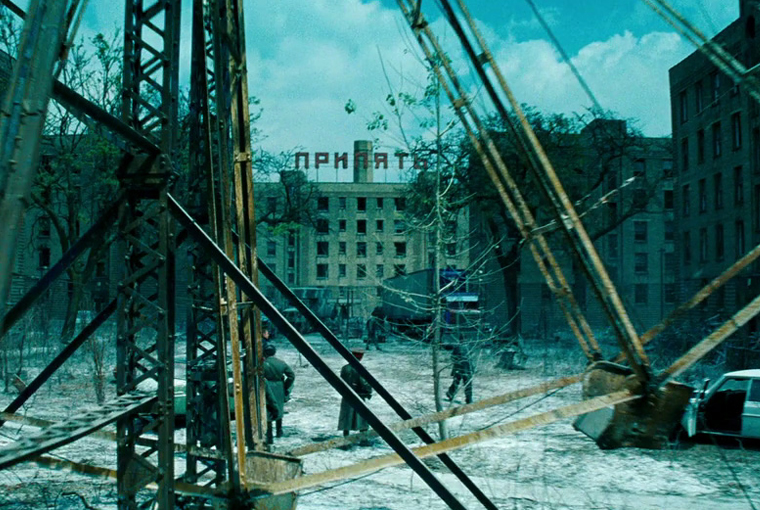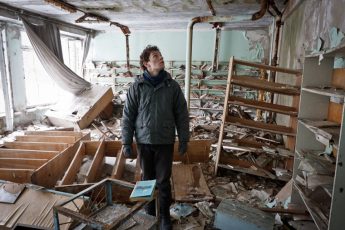Chernobyl: The Red Eyes of the Predator
Popular U.S. American Cinematographic Depictions of Chernobyl
Vol. 65 (May 2016) by Tetiana Ostapchuk
To the north, near the Belarus border, a pair of red lights on the Chernobyl towers blink slowly in the night as if they, too, can hear the violin. The red eyes of the predator, momentarily taken by the music, blinking to clear away its tears.”
Michael Beres, Chernobyl Murders
In American movies, the topic of ecological and nuclear disasters has a long history. For example, two weeks before the partial meltdown at Three Mile Island that occurred on March 28, 1979, the film The China Syndrome was released. It tells the story of a journalist who assists a plant supervisor in raising public awareness for safety violations at nuclear power plants. One of the lead characters was played by Jane Fonda who started to lobby against nuclear power after the Three Mile Island accident. Followed by public protests and crucial government measures, the accident stimulated the rise of humorous and carnevalesque representations of nuclear explosions in American popular culture (e.g. ads for the ‘Toxic Waste’ candy and ‘Atomic Fire Blast’ gum). The explosion of Chernobyl’s fourth reactor was not only seen as a countdown for the collapse of the Soviet empire but as a possible prelude to a global apocalypse. The American film industry started to explore this theme on different levels: in serious documentaries, popular movies, and even through cartoons. The cinematographic representation of Chernobyl encompasses at least four distinct perspectives: the incident as a technological disaster (this approach is more typical for documentaries), as a human tragedy (mainly in dramas), as an apocalyptic event with unpredictable outcomes (in horror movies and thrillers), and simply as a background setting (in action and sci-fi movies).
In American popular movies Chernobyl has thus occupied a distinct niche that started to emerge in the 1990s with the release of the first related movie, Collapse (Raspad). The film was the last project by Soviet-Ukrainian director Mikhail Belikov. It was produced at the Dovzhenko Film Studio (Kyiv, Ukraine) with the support of the Goskino Film Studio (Moscow, Russia) and Peter O. Almond Productions, Pacific Film Fund (USA). The film was presented at the Toronto Film Festival in September 1990 under the title Decay and at the Venice Film Festival, where it was nominated for the Golden Lion (the director won the The President of the Italian Senate’s Gold Medal for it). Collapase depicts the chaos of the first days after the nuclear meltdown and attempts to capture the first signs of the Soviet Union’s impending collapse. The movie thus focuses on the downfall of ethical norms and interpersonal relations in a totalitarian state. The events are presented from an insider point of view, and the plot is driven by questions of who was responsible for the catastrophe and what were its consequences for personal and public life. Having lost their conviction that the Soviet state will protect them, the characters are confronted with a situation of complete powerlessness.
The first popular foreign vision of the Chernobyl disaster was only presented in 1994 in the episode “The Host” of The X-Files, which was in its second season at the time. In tune with the main mission of the two leading characters to investigate cases involving marginalized paranormal phenomena, agents Fox Mulder and Dana Scully face a tapeworm-like humanoid “Flukeman” who attacks people and injects them with death-causing flukes. In their investigation the agents find out that the Flukeman was brought to New Jersey by a Russian freighter that was salvaged from Chernobyl. In 1997 the plot of this episode was adapted by Les Martin into a young adult-series novel entitled The Host. 2013 saw a comeback of the same character in a comic continuation of The X-Files called Season 10. The comic discloses a different backstory for the Flukeman, depicting him as a Soviet ex-liquidator named Gregory who mutated into the original Flukeman after the meltdown. In contrast to many other plots of the The X-Files series, the story of “Host” capitalized on existing anxieties about the Chernobyl explosion and its consequences. Eight years after the disaster, genuine fears evaporated and gave way to exaggerations and stereotypes.
Ukraine only gained its independence in 1992, and continued to be largely invisible to the global community in most spheres of life, including the film industry. The first explicit reference to Ukraine in an American movie only appeared in 1994 in the thriller Royce, and then in 1996, in Jackie Chan’s Hong Kong action flic First Strike along with the first appearance of a representation of a Ukrainian character in the popular TV-series Seinfield (Season 6, Episode 12 The Label Maker, 1995). Attempting to depict a new geopolitical order in Europe, directors and screenwriters could not overcome the problem of the limits of their understanding of foreign cultures. In Wilfried Nippel’s words: “Selection of what is deemed worth reporting is informed by one’s own idea of normality. Whatever is atypical to the eye of the observer appears as typical to the society to which it refers, and all the more so if the description cites only one or two characteristics”1. Similarly, the mid 1990s formed a stereotyped image of Ukraine as an unknown radioactive and warlike territory. The country was still closely associated with its Soviet past to the extent that it had not until recently been differentiated from Russia at all. It was not a coincidence that the Flukeman was brought to the US by a Russian ship. The inventors of the Flukeman simply projected on him their imagination of Chernobyl as an opposite, hostile world. This characteristic applied to the whole Ukrainian society for which Chernobyl and/or the surrounding Zone of exclusion have been used as close metonyms.
The Dead Zone has become a symbolic place of oblivion packed with mutants, monsters, zombies, and genetically modified creatures. It is often a paramount location for original computer games. This attitude also becomes clear from a recent interview of bestseller author Orest Stelmach, who juxtaposes the Zone in Chernobyl and New York as the two most contrasting places on the planet in The Boy From Reactor 4: “I initially was looking for a place that was an opposite of New York. I wanted a very dark place.” He claims that “[i]t’s really an ode to my parents for having immigrated, for giving birth to me here in the United States and giving me all these freedoms”.2 It is obvious that Ukraine has stayed a distant, dangerous, and ill-fated place for most Americans, even for those with Ukrainian roots. On his personal webpage, the author also announced that “Adam Rosenfelt’s and Maureen Meulen’s Atomic Entertainment (By Way of Helena, Mr. Brooks) has purchased the film rights to The Boy From Reactor 4 and to the author’s screenplay adaptation. The author also features as the project’s executive producer.”3 A new Chernobyl movie is just around the corner.
Transformers: Dark of the Moon is a 2011 American superhero film, the third in the series. It is a spin-off derived from already existing works such as the Transformers toy line (1984-), comic book series (Marvel Comics, 1984–1993; Dreamwave Productions, 2002–2004; IDW Publishing 2005-), animated television series, mangas, and other products in the Transformers franchise. The earliest reference to Chernobyl can be found in a story called Blood on the Tracks that Marvel Comics issued in September 1986. It features the story of the first mobile nuclear power station “Alpha”, a place heavily protested by environmentalists. A banner of one of the protesters admonishes the supporters for not having learned from Chernobyl. The 2011 movie depicts an alternative history involving a US space program and the Chernobyl plant meltdown. There is mention of a secret place used by the former Soviet government to perform experiments with a fuel cell stolen from the powerful space station “Ark.” The attempt failed and the catastrophe devastated the territory around the site. Once again Chernobyl is closely associated with the former Soviet regime and is pictured as a source of peril for the whole planet. The place is not just a home for the super-villain Shockwave and his pet, the Driller. It is also closely connected with corrupted Russian authorities, who represent an overpowering menace to civilized, Western modes of being. The fight scene in Chernobyl follows a scene showing a military terrorist base somewhere in the Middle East that creates yet another string of negative associations.
The only American popular movie which directly depicts Chernobyl as a site of black tourism is the 2012 horror film Chernobyl Diaries directed by Bradley Parker. It is a spooky story about six American vacationists who, looking for extreme emotions, hire a Ukrainian guide Yuriy, a former Soviet soldier, to help them travel the ruinous sites. He takes them to the ghost town of Prypiat, which was abandoned in 1986. During their trip they stumble upon evidence which suggests that not all workers were evacuated after the Chernobyl accident. Many of them had actually been left behind in the Zone as radioactive patients. Those who could escape from the clinic now wander around at night killing all living creatures, including Yuriy and four of the American travelers. In a late scene, two survivors are detected by ‘brave’ Ukrainian guards who first shoot one of them, Paul, and then throw the other, his girlfriend, in a cell with mutant patients. During the whole movie, numerous monsters are barely visible, which makes them appear rather unfrightening (visually, the Flukeman may yet be the scariest representation). But this movie is nevertheless a very intriguing representation of the main visual stereotypes discussed above. Initially, a positive message is conveyed: the opening lists Kyiv among other European cities and presents it as a destination for American tourists. But at the same time, all of the characters dream to get to Moscow and one of them even leaves to get engaged there. Chernobyl becomes an insurmountable obstacle on their way to future prospects. The film stereotypes Ukrainians (Yuriy, two Chernobyl guards, etc.), making them easily recognizable by their huge bodies and ‘gloom and doom’ facial expressions. This standardized representation conveys an unmistakably negative message about the country, its traditions, norms of behavior, and culture in general. The depiction of Prypiat City is reduced to a couple of multi-storied buildings, a replica of an iconic Ferrell Wheel, and a vast emptiness marked with car remnants and children’s toys here and there. Interestingly, the movie was filmed in Hungary and Serbia. The Old Soviet Air Force Base in Kiskunlacháza (Hungary) was used to shoot Chernobyl scenes. The place is gradually becoming a screen-twin of Prypiat and the Chernobyl Zone. It was also used for filming another movie in our list.
A Good Day to Die Hard, a 2013 action movie by John Moore, was a critical failure. Receiving mostly negative reviews, it brings to mind the critical reception of Chernobyl Diaries with just one difference – the Die Hard film became a box office hit and grossed over three times its budget worldwide. The main result of such popularity is that its imagery is more recognizable and has more chances of persuading mass consciousness. The plot, McClain’s traveling to Russia to save his son from terrorists, is reminiscent of and inspired by a classical Cold War Hollywood matrix: a black-and-white distinction between the civilized Western world and the humanity-threatening East. In this context, the choice of Chernobyl as a setting only intensifies the gap. The location is used as a ready-made dread deprived of any associations with tragedy or human loss and suffering. It is an uninhabited place that gets totally destroyed in the final scene, thus enhancing the ‘civilized heroe’s’ mission to save the entire world from corrupted Russian Mafiosi while protecting the priceless life of an American and the eternal values of family bonds. Yet again, Chernobyl is politically and geographically indistinguishable from the Russian state. The site is turned into an artificial setting used to justify the movie’s aim: entertain viewers through hyperbolization and stereotypization to a fault.
It has become customary for Western popular movies to depict Chernobyl as a place of evil. This geopolitical charge should be seen in close connection to the process of visual stereotypization of Ukraine and Ukrainians in general. Because Chernobyl often figures as the first and only introduction to the country, the negative imagery associated with it is typically applied to the Ukrainian society as a whole. The result is a cultural catalogue of exaggerated and often distorted visions. Will the red eyes of the predator ever clear away its tears?




Leave a Comment